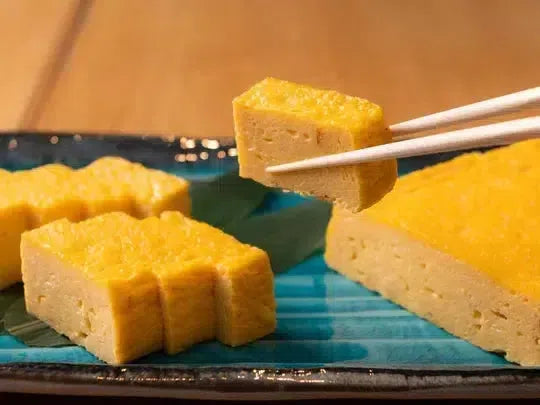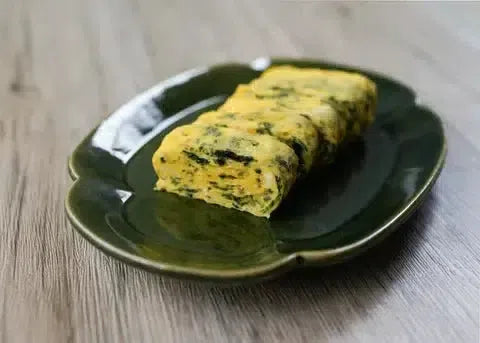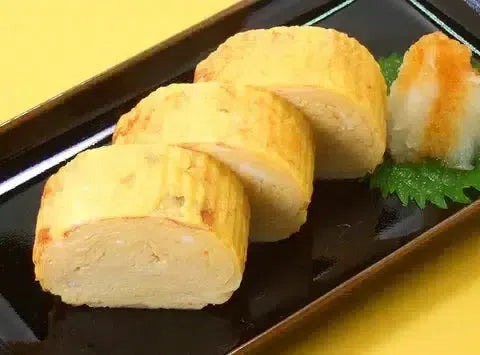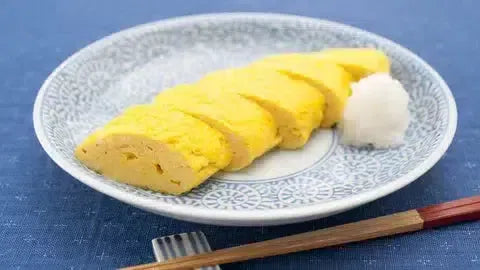
Jump to:
Tamagoyaki literally means "grilled egg" in Japanese. It is a Japanese style omelet, where each layer is cooked and rolled. The multiple layers result in an omelet that is fluffy, tender and moist. Want to learn more about Tamagoyaki? Stay tuned to learn everything you need to know about this yummy and fluffy Japanese omelet.
Variations of Tamagoyaki

Other than its unique texture, tamagoyaki differs from Western style omelets in its flavor as well. Tamagoyaki has an umami flavor, sometimes with a hint of sweetness, depending on which version you have. It is often served with grated radish and soy sauce. Sometimes, other ingredients like spring onion or seaweed, or even eel, are wrapped inside the layered rolls of tamagoyaki, to make it more delicious and balanced. Tamagoyaki can be eaten as is, paired with rice, or even sandwiched between two pieces of bread. No matter how you choose to eat it, it will undoubtedly be delicious.
Tamagoyaki is a staple dish of Japanese home cooking and in restaurants. Every family, and every chef, has their own tamagoyaki recipe, with slight variations or with additional ingredients to jazz it up. It is often added in bento (lunch box) and is tasty whether eaten warm or cold. While many Japanese people opt to eat tamagoyaki for breakfast, it is a perfect accompaniment for any time of the day, and can be eaten for breakfast, lunch, dinner or even for tea time, if you so desire. Traditionally, however, tamagoyaki was apparently served at the end of the meal, as a dessert.
Regional Differences
There are different kinds of tamagoyaki depending on the region of Japan. For example, atsuyaki tamago is a sweetened version more commonly found in the Kanto region, while dashimaki tamago is a more savory version found in the Kansai region.
Atsuyaki Tamago

Atsuyaki tamago, which means “thickly grilled eggs”, consists of slightly thicker layers than dashimaki tamago. It is sweeter, with the addition of sugar or mirin, and the added soy sauce gives it a slightly browned appearance. To make the tamagoyaki its trademark bright yellow color, usukuchi (light colored) or shiro (white) soy sauce can be used in place of the usual soy sauce.
Dashimaki Tamago

Dashimaki tamago means “rolled egg with dashi”, and is usually found in the Kansai region. This added dashi stock liquid gives it a softer texture and makes it more moist. For a beginner making this dish at home, the extra liquid could make the layers harder to roll, so some recipes advocate adding a minimal amount of dashi. Another distinct difference is that after cooking dashimaki tamago, its shape is perfected using a sushi mat. The back of the mat is often used, forming a stripy pattern on the surface of the omelet.
Tamagoyaki: A Chef’s Test

Tamagoyaki is reputed to be the litmus test of a chef's skill. In sushi restaurants, the tamago sushi - sushi rice topped with a slice of Japanese omelet - is supposedly one of the key dishes that reveal a sushi chef’s skill. While the ingredients in tamagoyaki are few, the ratio and the way it is cooked can be so distinct that it even becomes a chef’s signature dish. It is said that some high-end sushi restaurants use a higher ratio of dashi for a silkier and more flavorful dish, as well as occasionally adding seafood into the mixture.
It is a powerful dish that has even made grown men cry. In Jiro Dreams of Sushi, a famous documentary on a master sushi chef and his restaurant, one of his apprentices highlighted the difficulty of making a good tamagoyaki, saying that "I had made over 200 that were all rejected. When I finally did make a good one... I was so happy I cried."
Making Tamagoyaki at Home

Tamagoyaki is such an essential dish that there are special pans dedicated to making it. When using a tamagoyaki pan, the layers of the omelet can be cooked more evenly and the soft pillowy texture can be easily achieved. The shape of the pans also ensures that you get straight edges for a more aesthetic presentation. If you want to learn more about tamagoyaki pans, you can read about them in this article.
Now that you know the importance of tamagoyaki in Japanese cuisine, this is one dish you must try. While making tamagoyaki at the level of a Michelin star chef may be elusive for most of us, it is actually a quick and simple dish that can be made at home. You could get it rolling with our simple recipe here.
When making tamagoyaki at home, you could certainly play around with different ingredients and create your own special variation. Some ingredients, like benishoga (pickled red ginger), spring onions, or aonori (seaweed), can be added into the egg mixture.
Where to Find Tamagoyaki in Japan

Tamagoyaki is available all over Japan. You can find it in a wide variety of dining establishments including:
- Teishokuya: (Japanese set meal restaurant): Tamagoyaki is often included in set meals for breakfast or lunch.
- Izakaya: (Japanese style bar): It is normally served with grated radish and soy sauce in Izakayas.
- Sushi restaurants: Tamago is one of the most popular sushi ingredients, especially for children. Tamagoyaki for sushi is usually sweet.


0 comments